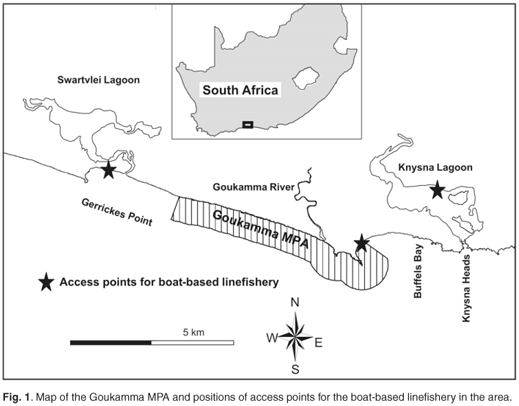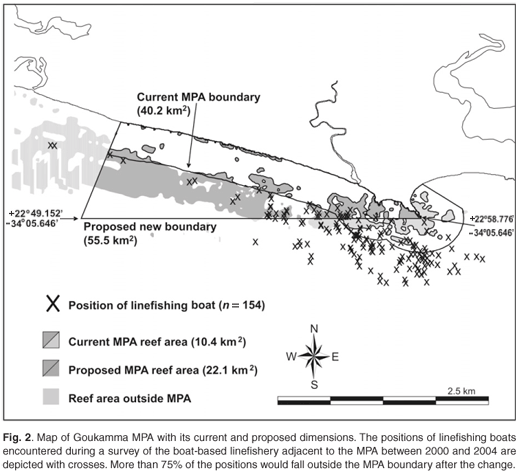Serviços Personalizados
Artigo
Indicadores
Links relacionados
-
 Citado por Google
Citado por Google -
 Similares em Google
Similares em Google
Compartilhar
South African Journal of Science
versão On-line ISSN 1996-7489
versão impressa ISSN 0038-2353
S. Afr. j. sci. vol.105 no.9-10 Pretoria Set./Out. 2009
COMMENTARY
A change of the seaward boundary of Goukamma Marine Protected Area could increase conservation and fishery benefits
Albrecht GötzI, *; Sven E. KerwathII; Colin G. AttwoodIII; Warwick H.H. SauerIV
IElwandle Node, South African Environmental Observation Network (SAEON), Private Bag 1015, Grahamstown 6140, South Africa
IIMarine and Coastal Management, Private Bag X2, Roggebay 8012, South Africa
IIIMarine Research Institute, Zoology Department, University of Cape Town, Private Bag, Rondebosch 7700, South Africa
IVDepartment of Ichthyology and Fisheries Science, Rhodes University, P.O. Box 94, Grahamstown 6140, South Africa
ABSTRACT
Goukamma Marine Protected Area (MPA) on the South African temperate South Coast has been shown to be effective in maintaining a spawning stock of roman, Chrysoblephus laticeps (Sparidae). The larval ecology and the oceanographic conditions in the area suggest a good potential for the enhancement of roman stocks outside the reserve through larval dispersal. A high rate of illegal fishing just inside the seaward boundary of the MPA could severely compromise its function. We suggest that a change of the seaward boundary of the reserve to coincide with a latitudinal line could increase its function as a harvest refuge for resident reef fishes such as roman, facilitate voluntary compliance and monitoring and prosecution of illegal fishing without a significant negative impact on the commercial linefishing fleet in the area. Simple adjustments such as the one proposed here could be attempted at a number of South African MPAs as they would be beneficial to achieve fishery and conservation goals alike.
Goukamma Marine Protected Area (MPA) is situated along the warm temperate South African South Coast. It extents about 18 km along-shore and one nautical mile (1.852 km) offshore, with a total area of approximately 40 km2 (Fig. 1). The reefs in and around Goukamma host a number of endemic temperate fish species such as roman, Chrysoblephus laticeps, a long-lived, protogynous sparid, which is one the most frequently caught reef fish species. Despite its small size the Goukamma MPA is effective in conserving a spawning population of roman with near pristine population parameters with regard to length frequency, sex ratio, size at maturity and sex change.1,2 This is caused by the high degree of residency of this species3,4 which limits post recruit 'spill-over' (net movement of adult fish into adjacent fishing grounds) from the MPA. The strong along-shore currents in the area and the larval ecology of this species suggest a high potential for larvae to be dispersed from Goukamma to fished areas and other MPAs.5

A fishery survey6 indicated a high rate of boat-based linefishing along the offshore boundary of the MPA (insert in Fig. 1) with frequent violations of this boundary. However, skipper interviews and seafloor surveys revealed that most of the effort was directed towards soft substratum species such as shallow water hake, Merluccius capensis, and migratory shoaling species such as dusky kob, Argyrosomus japonicus, and geelbek, Atractoscion aequidens. Only 10% of the interviewed skippers were targeting reef fishes. Data extracted from the National Marine Linefish System (NMLS; Marine and Coastal Management, unpublished data), a database that houses the commercial catch returns, confirmed the survey information. The percentage of reef-associated fish in the catch showed a steady decline since 1985 and only between 1 and 10% of the catches between 2000 and 2006 comprised reef-associated species.
During interviews with skippers fishing inside the boundaries of the MPA uncertainties on the exact location of the boundaries and drift fishing for shoaling species were the most frequently stated reasons for the transgressions. As the MPA offshore boundary is defined by the distance of one nautical mile from the shore line there are indeed serious limitations for voluntary compliance, as the shore includes rocky headlands and bays and the exact boundary depends on the algorithm used in its calculation. The fact that the boundary is not defined by geographical coordinates7 also precluded a successful prosecution of illegal fishers, even when fishing occurred at a considerable distance inside the MPA boundary (Rhett Hiseman, Cape Nature, pers. comm.).
Based on ecological considerations, we suggest a change of the MPA boundary to a latitude line (Fig. 2). The new boundary would have several advantages. First, the area off the Goukamma River, where most transgressions occurred, is opened to fishing. As the vast majority of the sea floor in this area is soft substratum, the shift would not have any negative effect on the vulnerable reef-associated species such as roman and will effectively increase the area available for the commercial linefishing fleet. Second, a large part of the previously unprotected reef area in the east of the MPA would fall inside its boundaries. According to the fishery survey this area is only occasionally fished and an inclusion would have a negligible effect on the linefishing fleet, but will effectively increase the area available for reef fish recovery by almost 120%. Third, a latitudinal boundary should remove any uncertainty about transgressions, as it can be easily monitored with a GPS receiver without any additional calculations. This should facilitate voluntary compliance and prosecutions of offenders alike.

Although it is recognised that the problems facing effective management of MPAs in South Africa are systemic and require significant input on a variety of levels, the boundary adjustment suggested here is likely to receive a broad acceptance during the required public participation process.
Apart from the lack of empirical evidence for the spill-over effect,8 the biggest criticism of MPAs as fishery management tools is the failure of many studies to take the effect of displacement of fishing power into account.9 The suggestions made here, however, are based on thorough investigations of ecological and fishery patterns. The proposed new MPA dimensions would increase the potential to enhance roman and other reef fish stocks in the area through increased export of fish eggs and larvae as a result of a larger protected reef habitat. Increased protection will particularly benefit larger sized roman1 which are either large females or males and which contribute disproportionately to the replenishment of the population. On the other hand, the effect on the commercial linefishing fleet in the area is negligible. Reef fish stocks have already collapsed10 and fishing for species such as roman has steadily decreased in recent years due to low catch rates, the high fuel prices and the availability of more abundant shoaling species closer to access points (Fig. 1).
More often than not, MPA boundaries are arbitrarily defined without a clear definition of the objectives associated with the declaration of that protected area. In the case of Goukamma, the MPA represents the seaward extension of the Goukamma Nature Reserve, whose staff is also responsible for the enforcement of the MPA.7 The changes proposed here facilitate the enforcement of the area closure and thereby increase the effectiveness of Goukamma without additional administrative requirements. While we recognise that the systemic problems in the management of MPAs in South Africa, including that of non-compliance, are unlikely to be solved in the short to medium term, we suggest that simple interventions such as the one proposed here, can, if based on ecological and fisheries' management criteria, go a long way in making MPAs more effective.
This project was funded in part by the National Research Foundation and the Marine Living Resources Fund. The fieldwork would not have been possible without the assistance offered by Cape Nature.
1. Götz A., Kerwath S.E., Attwood C.G. and Sauer W.H.H. (2008). Effects of fishing on population structure and life history of roman Chrysoblephus laticeps (Sparidae). Mar. Ecol. Progr. Ser. 362, 245–259. [ Links ]
2. Kerwath S.E., Götz A., Attwood C.G. and Sauer W.H.H. (2008). The effect of marine protected areas on an exploited population of sex-changing temperate reef fish: an individual-based model. Afr. J. Mar. Sci. 30, 337–350. [ Links ]
3. Kerwath S.E., Götz A., Attwood C.G. and Sauer W.H.H. (2007). Area utilization and activity patterns of roman Chrysoblephus laticeps (Sparidae) in a small marine protected area. Afr. J. Mar. Sci. 29, 259–270. [ Links ]
4. Kerwath S.E., Götz A., Attwood C.G., Cowley P.D. and Sauer W.H.H. (2007). Movement pattern and home range of roman Chrysoblephus laticeps. Afr. J. Mar. Sci. 29, 93–103. [ Links ]
5.Götz A., Kerwath S.E., Attwood C.G. and Sauer W.H.H. (in press). Effects of fishing on a reef community in South Africa II: benthic invertebrates and algae. Afr. J. Mar. Sci. 31, doi: 10.2989/ AJMS.2009.31.2.13.885. [ Links ]
6. Götz A. (2005). Assessment of the effect of Goukamma Marine Protected Area on community structure and fishery dynamics. Ph.D. thesis, Rhodes University, Grahamstown, South Africa. [ Links ]
7. Hiseman R. (1998) Goukamma marine protected area management plan. Unpublished report, Western Cape Nature Conservation Board. [ Links ]
8. Willis T.J., Millar R.B., Babcock R.C. and Tolimieri N. (2003) Burdens of evidence and the benefits of marine reserves for fishery management: putting Descartes before des horse? Environ. Cons. 30, 97–103. [ Links ]
9. Hilborn R., Stokes K., Maguire J-J., Smith T., Botsford L.W., Mangel M., Orensanz J., Parma A., Rice J., Bell J., Cochrane K.L., Garcia S., Hall S.J., Kirkwood G.P., Sainsbury K., Stefansson G. and Walters C. (2004) When can marine reserves improve fisheries management? Ocean & Coast. Manag. 47, 197–205. [ Links ]
10. Griffiths M.H. (2000) Long-term trends in catch and effort for the Cape commercial linefishery: snapshots of the 20th Century. S. Afr. J. Mar. Sci. 22, 81–110. [ Links ]
* Author for correspondence E-mail: albrecht@saeon.ac.za














